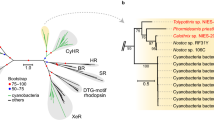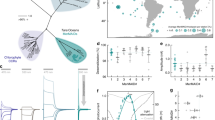Abstract
Due to the unique capability of modulating cell membrane potential upon photoactivation, channelrhodopsins of green (Chlorophyta) and cryptophytic (Cryptophyta) algae are widely employed in optogenetics, a modern method of light-dependent regulation of biological processes. To enable the search for new genes perspective for optogenetics, we have developed the PCR tests for the presence of genes of the cation and anion channelrhodopsins. Six isolates of green algae Haematococcus and Bracteacoccus from the White Sea region and 2 specimens of Rhodomonas sp. (Cryptophyta) from the regions of White and Black Seas were analyzed. Using our PCR test we have demonstrated the known Haematococcus rhodopsin genes and have discovered novel rhodopsin genes in the genus of Bracteacoccus. Two distantly homologous genes of anion channelrhodopsins were also identified in the cryptophytic Rhodomonas sp. from the White and Black Seas. These results indicate that the developed PCR tests might be useful tool for a broad-range screening of the Chlorophyta and Cryptophyta algae to identify unique channelrhodopsin genes.




Similar content being viewed by others
Abbreviations
- ACR:
-
anion channelrhodopsin
- CCR:
-
cation channelrhodopsin
References
Govorunova, E. G., Sineshchekov, O. A., and Spudich, J. L. (2022) Emerging diversity of channelrhodopsins and their structure-function relationships, Front. Cell. Neurosci., 15, 800313, https://doi.org/10.3389/fncel.2021.800313.
Sineshchekov, O. A., Jung, K.-H., and Spudich, J. L. (2002) Two rhodopsins mediate phototaxis to low- and high-intensity light in Chlamydomonas reinhardtii, Proc. Natl. Acad. Sci. USA, 99, 8689-8694, https://doi.org/10.1073/pnas.122243399.
Nagel, G., Ollig, D., Fuhrmann, M., Kateriya, S., Musti, A. M., et al. (2002) Channelrhodopsin-1: a light-gated proton channel in green algae, Science, 296, 2395-2398, https://doi.org/10.1126/science.1072068.
Nagel, G., Szellas, T., Huhn, W., Kateriya, S., Adeishvili, N., et al. (2003) Channelrhodopsin-2, a directly light-gated cation-selective membrane channel, Proc. Natl. Acad. Sci. USA, 100, 13940-13945, https://doi.org/10.1073/pnas.1936192100.
Boyden, E. S., Zhang, F., Bamberg, E., Nagel, G., and Deisseroth, K. (2005) Millisecond-timescale, genetically targeted optical control of neural activity, Nat. Neurosci., 8, 1263-1268, https://doi.org/10.1038/nn1525.
Deisseroth, K. (2015) Optogenetics: 10 years of microbial opsins in neuroscience, Nat. Neurosci., 18, 1213-1225, https://doi.org/10.1038/nn.4091.
Govorunova, E. G., Sineshchekov, O. A., Liu, X., Janz, R., and Spudich, J. L. (2015) Natural light-gated anion channels: a family of microbial rhodopsins for advanced optogenetics, Science, 349, 647-650, https://doi.org/10.1126/science.aaa7484.
Nakao, S., Kojima, K., and Sudo, Y. (2021) Microbial rhodopsins as multi-functional photoreactive membrane proteins for optogenetics, Biol. Pharm. Bull., 44, 1357-1363, https://doi.org/10.1248/bpb.b21-00544.
Klapoetke, N. C., Murata, Y., Kim, S. S., Pulver, S. R., Birdsey-Benson, A., et al. (2014) Independent optical excitation of distinct neural populations, Nat. Methods, 11, 338-346, https://doi.org/10.1038/nmeth.2836.
Sahel, J. A., Boulanger-Scemama, E., Pagot, C., Arleo, A., Galluppi, F., et al. (2021) Partial recovery of visual function in a blind patient after optogenetic therapy, Nat. Med., 27, 1223-1229, https://doi.org/10.1038/s41591-021-01351-4.
Govorunova, E. G., Sineshchekov, O. A., Li, H., Wang, Y., Brown, L. S., et al. (2021) Cation and anion channelrhodopsins: sequence motifs and taxonomic distribution, mBio, 12, e0165621, https://doi.org/10.1128/mBio.01656-21.
Chekanov, K., Lobakova, E., Selyakh, I., Semenova, L., Sidorov, R., et al. (2014) Accumulation of astaxanthin by a new Haematococcus pluvialis strain BM1 from the white sea coastal rocks (Russia), Mar. Drugs, 12, 4504-4520, https://doi.org/10.3390/md12084504.
Chekanov, K., Fedorenko, T., Kublanovskaya, A., Litvinov, D., and Lobakova, E. (2020) Diversity of carotenogenic microalgae in the White Sea polar region, FEMS Microbiol. Ecol., 96, fiz183, https://doi.org/10.1093/femsec/fiz183.
Stanier, R. Y., Kunisawa, R., Mandel, M., and Cohen-Bazire, G. (1971) Purification and properties of unicellular blue-green algae (order Chroococcales), Bacteriol. Rev., 35, 171-205, https://doi.org/10.1128/br.35.2.171-205.1971.
Walne, P. R. (1970) Studies on the food value of nineteen genera of algae to juvenile bivalves of the genera Ostrea, Crassostrea, Mercenaria, and Mytilis, Fish. Invest., 26, 1-62.
Keeling, P. J., Burki, F., Wilcox, H. M., Allam, B., Allen, E. E., et al. (2014) The Marine Microbial Eukaryote Transcriptome Sequencing Project (MMETSP): illuminating the functional diversity of eukaryotic life in the oceans through transcriptome sequencing, PLoS Biol., 12, e1001889, https://doi.org/10.1371/journal.pbio.1001889.
Jékely, G. (2009) Evolution of phototaxis, Philos. Trans. R Soc. Lond. B Biol. Sci., 364, 2795-2808, https://doi.org/10.1098/rstb.2009.0072.
Govorunova, E. G., Sineshchekov, O. A., and Spudich, J. L. (2016) Structurally distinct cation channelrhodopsins from Cryptophyte algae, Biophys. J., 110, 2302-2304, https://doi.org/10.1016/j.bpj.2016.05.001.
Wang, Y., Tian, R. M., Gao, Z. M., Bougouffa, S., and Qian, P.-Y. (2014) Optimal eukaryotic 18S and universal 16S/18S ribosomal RNA primers and their application in a study of symbiosis, PLoS One, 9, e90053, https://doi.org/10.1371/journal.pone.0090053.
Krasnova, E. D., Pantyulin, A. N., Matorin, D. N., Todorenko, D. A., Belevich, T. A., et al. (2014) Cryptomonad alga Rhodomonas sp. (Cryptophyta, Pyrenomonadaceae) bloom in the redox zone of the basins separating from the White Sea, Mikrobiologiia, 83, 346-354.
Govorunova, E. G., Sineshchekov, O. A., Rodarte, E. M., Janz, R., Morelle, O., et al. (2017) The expanding family of natural anion channelrhodopsins reveals large variations in kinetics, conductance, and spectral sensitivity, Sci. Rep., 7, 43358, https://doi.org/10.1038/srep43358.
Govorunova, E. G., Sineshchekov, O. A., Hemmati, R., Janz, R., Morelle, O., et al. (2018) Extending the time domain of neuronal silencing with cryptophyte anion channelrhodopsins, eNeuro, 5, ENEURO.0174-18.2018, https://doi.org/10.1523/ENEURO.0174-18.2018.
Chekanov, K., Litvinov, D., Fedorenko, T., Chivkunova, O., and Lobakova, E. (2021) Combined production of astaxanthin and β-carotene in a new strain of the microalga Bracteacoccus aggregatus BM5/15 (IPPAS C-2045) cultivated in photobioreactor, Biology, 10, 643, https://doi.org/10.3390/biology10070643.
Acknowledgments
The authors express their gratitude to A. N. Khanaichenko (Institute of Biology of Southern Seas, Russian Academy of Sciences) and to T. A. Fedorenko (Lomonosov Moscow State University) for providing cultures and recommendations of their cultivation. The support of the scientific and educational school of LMSU “Molecular technologies of living systems and synthetic biology” is appreciated.
Funding
This work was financially supported by the Ministry of Science and Higher Education of the Russian Federation, agreement 075-15-2021-1396.
Author information
Authors and Affiliations
Contributions
E. S. Lobakova, O. V. Karpova – concept of the study and supervision; E. N. Vinogradova, O. V. Karpova – conducting experiments; E. S. Lobakova, O. V. Karpova, and E. N. Vinogradova – discussion of the results of the study; O. V. Karpova – writing the manuscript; E. S. Lobakova, E. N. Vinogradova – editing the paper.
Corresponding author
Ethics declarations
The authors declare no conflict of interest in financial or any other sphere. This article does not contain any studies with human participants or animals performed by any of the authors.
Rights and permissions
About this article
Cite this article
Karpova, O.V., Vinogradova, E.N. & Lobakova, E.S. Identification of the Channelrhodopsin Genes in the Green and Cryptophytic Algae from the White and Black Seas. Biochemistry Moscow 87, 1187–1198 (2022). https://doi.org/10.1134/S0006297922100121
Received:
Revised:
Accepted:
Published:
Issue Date:
DOI: https://doi.org/10.1134/S0006297922100121




